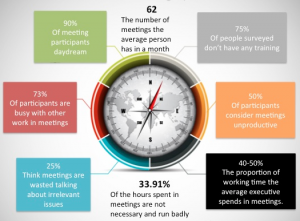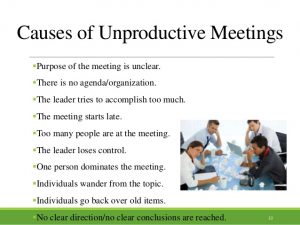Why Meetings are Hated and Unproductive: What to do About It
By Ray Williams, January 28, 2019

Have you ever sat through a meeting and said to yourself, “what a waste of time, I could be getting my work done.” If your answer is yes, you are not alone. Meetings take up an ever-increasing amount of employees’ and executives’ time, which has been a contributor to the expanding work day.
While meetings can be a useful strategy and process for sharing work progress,and connecting with others, excessive and poorly run meetings can have a significant negative effect on productivity and employee motivation. Research has proved this over and over again.
Most workers view the prospect of a two-hour meeting with the same enthusiasm as Prometheus awaited the daily arrival of the eagle, sent by the gods to peck at his liver. Meetings have been a form of torture for office staff for as long as they have pushed pencils and bashed keyboards.
Meetings are a hidden operating expense that often cost businesses more than they realize. While the typical goal of a meeting is to get things done, the reality is that most meetings only serve as a time sink.
What Research Says
According to a study by Microsoft, most of us only spend about three days a week actually working. Unnecessary meetings top the list as our biggest time-wasters, so if an employee needs to work instead of attend a meeting, let them.
In a report by Harvard Business Review, more than 70 percent of the 182 senior managers surveyed agreed that said meetings are unproductive and inefficient. Respondents said meetings keep them from completing their own work (65 percent), come at the expense of deep thinking (64 percent), and missed opportunities to bring the team closer together (62 percent).
The firm Sharp Europe reported in their study that 63 percent of meetings didn’t have a planned agenda. A study by Microsoft showed that unclear objectives, lack of team communication and ineffective meetings are among the top time wasters that workers around the world say make them feel unproductive for as much as a third of their workweek on average.
Beyond reduced productivity, excessive meetins can even pose a health threat. According to Public Health England CEO, Duncan Selbie, sitting in meetings slows down metabolism and reduces the body’s capacity to regulate its sugar and thus blood pressure. These effects can lead to obesity, diabetes, cancer and even death.

According to Inc. and the online meeting company, Fuze, here are some staggering meeting statistics to ponder:
- More than $37 billion per year is spent on unproductive meetings (Business Insider, Inc, BABM, The British Psychological Society)
- 15% of an organization’s collective time is spent in meetings.
- Middle managers spend 35% of their time in meetings.
- Upper management spends 50% of their time in meetings.
- People spend up to 4 hours per week preparing for status update meetings.
- Most meetings are unproductive – In fact, executives consider more than 67% of meetings a failure.
- 39% of meeting participants admitted to dozing off during a meeting.
- Over 70% brought other work to meetings.
- The researchers found that the more meetings employees attended, the more exhausted they felt and the higher they perceived their workload to be.
There are 11 million meetings in the US per day according to Wall Street Journal, Forbes, CBS News, HRM America, CNBC NPR’s Marketplace, Inc.com, MIT Sloan Management Review.
A meeting analysis by Romano and Nunamaker shows that, year over year, employees spend more and more of their workday attending meetings, with most of them being unproductive, and high-cost senior executives spend significantly even more of their time in meetings. Over the past 50 years, both the length and frequency of meetings has increased.
Some meeting costs that can be easily overlooked. Harvard Business Review developed a Web app that calculates how much a meeting costs a company. You will need the following information:
- Length of meeting.
- Number of Attendees.
- Wages and salaries for those who prepare the meeting (including attendees, secretaries, set up crew, etc.)
- Time spent preparing agendas and meeting papers.
- Cost of materials used for the meeting (handouts, visuals, etc.)
- Overhead costs for the facilities for length of meeting.
- Cost of speaker or facilitator, if applicable.
- Cost of travel, lodging, meals, etc. if meeting is held out of office.
- Cost of any additional miscellaneous expenses incurred due to holding the meeting
Estimate the cost of a meeting to determine whether you are getting your desired ROI.
in a study for Harvard Business Review, a group of consultants from Bain & Company analyzed the calendars of key employees for one company and found that one weekly executive meeting consumed 300,000 hours each year. Here’s the specific breakdown:
- A weekly meeting took up 7,000 hours for the top executives involved.
- Another 20,000 hours of meetings among department heads and executives were generated in preparation for the meetings listed above.
- Each team averaged 63,000 hours in preparation and generated an additional 210,000 hours in more preparatory meetings.
According to a Clarizen/Harris Interactive survey, 60% of employees think status update meetings waste valuable time, and 70% say these meetings don’t help them get any work done.And 67% of those surveyed say they are spending up to four hours per week getting ready for their next status update meeting. And according to a survey by Office Team45 percent of senior executives surveyed said that their employees would be more productive if their firms banned meetings for a least one-day a week.
Brain research may provide us with another reason to not have meetings. Research by University of Minnesota psychologist Kathleen Vohs and her colleagues as well as other neuroscientists, indicates that we have a limited amount of cognitive or what they call “executive” resources. Once they get depleted, we make bad decisions or choices. Business meetings require people to commit, focus and make decisions, with little or no attention paid to the depletion of the finite cognitive resources of the participants–particularly if the meetings are long. So if that is true, the three or four hour project meetings may be counterproductive.

The Problems with Meetings and Solutions
Problem: Too many distractions. Ah, the siren song of your text or email chime. It’s almost impossible to ignore, but it guarantees that you will miss out on what’s being said in the meeting, wasting your time as well as that of everyone else in the room.In fact, 92% of Fuze survey respondents confessed to multitasking during meetings, whether checking email or doing other work. Solution:Control or Eliminate Distractions.The best way to stay focused on the meeting is to leave that distracting device behind. And if you’re the meeting organizer, it’s OK to ask attendees to just leave their phones, laptops and tablets at their desk. Hand out some old-school notepads and encourage note taking by hand. Also, the meeting organizer should make it clear to participants that they are not to bring other work to meeting
Problem: The meetings are chaotic or even out of control. Solution: The meeting leader or facilitator should receive training or coaching in how to run a meeting. If the senior leader doesn’t have that skill set it should be delegated to someone else. A set of rules of conduct and process should be established and enforced and should include:
- Only one person speaking at a time, and to the point: Comments already made cannot be repeated.
- No interruptions of someone speaking.
- No personal attacks allowed.
- Non-participation is not an option
Problem: Too many attendees, and unnecessary attendees. Often, a blanket invitation to everyone in the department or might be involved are invited to attend the meeting. Sometimes, invitations are sent because the meeting organizer doesn’t want to hurt the feelings of someone who is not invited. Solution:Limit the number of attendees.Less is more. Really. When there are too many people — or the wrong people — you’re going to end up with off-target tangents and input that doesn’t solve your issues. Plus, when people can’t get a word in edgewise, they tend to tune out. In fact, meetings are most effective when they include just five people. According to studies, a meeting of more than 20 is effectively useless. Consider borrowing Amazon CEO Jeff Bezos’ Two Pizza Rule: Make the attendee list small enough that two pizzas adequately feeds the group. Not only does this keep meetings productive, but it also guards against groupthink. Another great rule of thumb is the Rule of 7, which is the ideal number for group tasks, including meetings. For every person over that magic number, the likelihood of making an executable decision goes down by 10 percent. That means that once you hit 16 or 17 people in the room, decision effectiveness is just about zero. So, figure out who needs to be there and only invite them. The others can be sent meeting notes if they really want to know what’s going on.
Problem: Meetings are too long.One of the biggest gripes from meeting attendees is that meetings are too long–sometimes several hours– which they complain actually detracts from their productivity and ability to do their own work. Solution:Limit the length of the meeting to one hour, or less. And end the meeting on time, even if the agenda is not completed.Consider having walking meetings rather than sitting down. Walking meetings can be a benefit for participants’ health and may also reduced the time needed. A related problem is the agenda has been covered and decisions have been made, yet you still have 20 minutes allocated to the meeting and you decide to deal with new or other items. Should you introduce a new topic or revisit something you’ve already adequately covered? There’s an adage that describes why you feel like you have to use up the whole hour: Work will expand to fit the time available, otherwise known as Parkinson’s Law. But you can — and should — break this law when the agenda items have been adequately covered.
Problem: Meetings start late and end late. A frequent complaint of meeting attendees is the late arrival of individual participants and/or meetings that go beyond the allocated time limit.There’s nothing worse than attending a meeting and not getting through all the topics, only to have to schedule a follow-up meeting. It takes discipline to keep meetings focused and moving. Solution:First, have a structured detailed advanced agenda with time limits for each item. Second, end the meetings at the posted time, even if the agenda is not completed. And finally, don’t let people who are late to the meeting by more than 15 minutes join.
Problem: Meeting agendas don’t exist or are vague. The agendas only have title or a few bullet points, but the purpose is not clear, and no background material is provided. Solution:A good meeting should have a detailed description about the items to be covered, preferably in the form of questions or actions to be taken, and a time allocation for each item, which should be followed rigorously. An indication also of who will speak to the item or introduce it is helpful.
Problem: Meetings that don’t have follow-up. Much is discussed at the meeting, but people leave not being clear as to what happens next.Solution: An agenda should clearly indicate decisions have to be made. After making the decision, a clear record should be made, including specific follow up actions to be taken and whose responsibility they are. People should not leave the meeting without that understanding.
Problem: Meetings are used for “social loafing.”When grouped together, individuals will often reduce their efforts in order to avoid doing more work than another team member. This might sound like a simple personality problem, but studies repeatedly find that individuals learn that their efforts as part of a group will not have as significant an impact as if they had done the work separately. Solution:Have a structured tight agenda which requires participants to prepare in advance and proactively participate. Connect work at the meeting with required work individually.
Problem: Certain attendees monopolize the conversation/meeting.A surefire way to have everyone else tune out is by having the meeting organizer or facilitator talking too much, or by allowing others to take over the meeting, or pursue sidebar conversations. Solution:Create an airtight agenda, which will set expectations for the meeting and allow attendees to adequately prepare. When people have time to gather their thoughts in advance, you’ll have a more productive conversation, so try to share the agenda a few days before your meeting. Effective agendas are much more than just a list of topics, so consider adding who will be talking about each topic (including if you want everyone prepared for a brainstorm) as well as how long is allocated for each topic, to help keep everyone on point.
Problem. Meetings utilize brainstorming as an activity to enhance creativity, involvement and productivity.Yet, after more than 60 years of scientific research, there is scant evidence that brainstorming produces better or more ideas than the same number of individuals working alone would produce. A meta-analytic review of more than 800 teams indicated that individuals are more likely to generate a higher number of original ideas when they don’t interact with others. Brainstorming is particularly likely to harm productivity in large teams when teams are closely supervised, and when performance is oral rather than written. Another problem is that teams tend to give up when they notice that their efforts aren’t producing very much. may be even more significant, is that brainstorming can actually hamper creativity. A study entitled “Collaborative Fixation: Effects of Others’ Ideas on Brainstorming,” by researchers Nichols Kohn and Steven Smith at Texas A&M University, and published in Applied Cognitive Psychology, shows that brainstorming may not be the best strategy to generate unique and varied ideas. The researchers concluded that group brainstorming exercises can lead to fixation on only one idea or possibility, blocking out other ideas and possibilities, leading eventually to a conformity of ideas. Lead researcher Nicholas Kohn explains, “Fixation to other people’s ideas can occur unconsciously and lead to you suggesting ideas that mimic your brainstorming partners. Thus, you potentially become less creative.” Solution. Investigate alternatives to brainstorming.One example is called “brainwriting,” in which participants write their ideas down silently; then after ideas have been captured, they are shared in the group; then the participants can build on each other’s ideas.Another approach is to have each participant write down one idea, then pass it to the person on the right or left in the group. That person’s task is to elaborate on the first idea, then pass it on to the next person. The process is repeated until every person in the group has elaborated on each person’s original idea. Then the ideas are shared in the group.Cognitive psychologist Tony McCaffrey proposes another, cooperative alternative. McCaffrey suggests an approach called “brainswarming,” which encourages individual ideation within the context of a larger objective. Brainswarming begins by placing a goal or problem at the top of a whiteboard, then listing the resources available to meet these problems at the bottom. Members of your team sit independently and write down ideas for tackling the problem from either end. McCaffrey has found that natural “top-down” thinkers will begin refining the goal, while “bottom-up” thinkers will either add more resources or analyze how resources can be used to solve problems. The magic happens in the middle, where these two approaches connect. Finally, an approach which is an alternative to brainstorming is just not to use it, but ask people individually to work on their own and suggest ideas.

A Meeting/Work Philosophy in Organizations
When leaders aren’t deliberate about a company’s meeting culture, meetings can quickly go from a productive part of day-to-day operations to a black hole time suck that cause more problems than they solve. This is why I am so passionate about founders being very careful with meeting culture. Cutting out many of your meetings actually leads to a more productive, engaged workforce.
Companies need to be purposeful about how meetings are scheduled and conducted. Err on the side of too many meetings, or meetings that are too long, and you are wasting the time and energy of your staff. Err on the side of too few, or too short, and you risk a lack of communication, information silos, and disjointed teams. Here’s some other suggestions that can be incorporated into your workplace meeting culture:
- Schedule a weekly, meeting-free day. It’s incredibly frustrating to open a calendar and see a week so jam-packed with meetings that it’s impossible to schedule time to actually work, which is why it comes as such a relief to open the calendar and see a day without scheduled commitments. I’ve seen some companies enforce only having meetings one day of the week, and I love this solution, though it might be more feasible for most companies to schedule one day a week that remains meeting-free. You can function as a company without meetings for one day a week, even if you or your managers don’t think so. Allow team members to schedule blocks of time every day that can’t be interrupted by meetings (or other interruptions). Research has shown that the amount and length of interruptions in the workplace has been increasing with a resulting drop in productivity and rise in stress levels.
- Make working alone a priority for everyone, not meetings.Author and TED Speaker Susan Cain shares more about teamwork and why, when implemented badly, it actually gets in the way of collaboration. In his biography, iWoz, Steve Wozniak points out how important it is for artists, inventors, and engineers, to work alone. “I don’t believe anything really revolutionary has been invented by committee.” – Steve Wozniak, iWoz. Instead of getting everyone together for a meeting, why not get the best from your people by making conditions optimal for them? I’ve got a fancy term for you: Asynchronous collaboration. Supporting a team of great employees means giving them the tools to do great work. Asynchronous collaboration is one of these tools. When work and opinions are shared and gathered without getting everyone in the same room or on a call at the same time, folks can find that sweet spot of solitude which gives them a better chance at producing excellence. If you need more support for the benefits of working alone, check out this research by Anders Ericsson [PDF].
- Conduct a meeting audit and pare them down. Less is more. If you think your company is holding too many meetings, take a cold, hard look at the frequency and kinds of meetings that are regularly scheduled. Then ask your VPs, directors, and managers to do the same. Don’t be afraid to ask them to justify why certain meetings are needed, or how they could replace them with something less time consuming and more agile.
- Allow for opt-outs for attendees. Trust your team to know what meetings they have to attend, and which ones they don’t. Give everyone the opportunity to just say no, especially for status meetings where they have little to contribute. If you schedule a meeting and need everyone to attend, just give them a heads up that it’s not a discretionary meeting.
- Clarify the purpose of your meetings. Research has shown that meetings are called for one/some or all of these purposes: Providing updates or information; asking for input or feedback; making a decision or asking for approval; providing encouragement/inspiration or recognition.
The only valid reason above is c) Making a decision or asking for approval. And sometimes – just sometimes d) Provide encouragement/inspiration or recognition.. A lot of meetings unfortunately, are a) and b). You should never use meetings to provide updates or information that can be done effectively via other means, as can asking for input or feedback.
Ban Critiquing of the initial presentation of ideas, proposals until they are all explored positively first. Often meetings are rife with arguments about perspectives, and participants’ perspectives or ideas are immediately met with criticism or attack sometimes of a personal nature. In a neuroscience study at Emory University, Gregory Berns discovered through MRI scans that the brain activates an involuntary fear of rejection when a person prepares to state an opinion that is different from the group’s ideas.“The brain regions associated with perception can be altered by social influences.” – Gregory Berns, Social Conformity Study. This results in an unwillingness for people to actively participate, and reduced creativity and productivity. Everyone gets to express their opinion from start to finish. And critical opinions should have their place only during the second part of the meeting.Whether they are right or wrong is not important at this moment, but the sole fact of interrupting and expressing their objection is a big focus breaker.
Use 21stCentury technological tools. First of all, let’s handle the elephant in the room. If it’s possible, have the meeting online instead of forcing people to show up at a certain location.
These days, there’s a ton of great software and other tools that you can use to make that happen. For example, one of the leaders in the online space Blue Jeans provides great video conferencing solutions in the cloud. And in the true 21st century spirit, it does work on all popular devices and systems. Another alternative you might look into is join.me. But that’s just one thing. Need an effective way to handle meeting notes? Try out Evernote. With it, you can assign a note-taker at each meeting, have them create the notes, and then share them with the rest of the team. You can also check out minutes.io, which can be a great alternative. It’s been designed specifically for meeting notes and has many of the common meeting note types already implemented. Having a brainstorming session? Give Trello a go. With its card-based design, it’s perfect for brainstorming and recording independent ideas along with some brief comments for each. For an offline alternative, check out FreeMind – the top mind mapping tool out there (available for Mac and PC). And Slack is a great group communication tool. Here’s 28 of the best collaboration tools for teams.
Use other Kinds of Collaboration Tools.
- Use a Wiki to create a collaboration document. Crowdsource information by utilizing Hackpad, Google Docs, Etherpad, or Zoho Docs. Instead of calling a meeting to review information, create an outline for the presenters to share the research that’s already been gathered. The rest of the team can collaborate by adding their comments, questions, and reactions in-line. Create checklists in the document, or simply track access to ensure that each reviewer has had the chance to complete their analysis.
- Utilize project management tools.Create a project, task, story, or ticket in a collaboration tool such as Asana, Trello, Basecamp, or TeamWeek. Whether it’s by moving a card from someone’s project list, or by assigning subtasks and checklists, contributions can be sorted and then summarized.
- Create a virtual whiteboard. Whiteboarding joins visual storytelling with systemic processes, and it doesn’t have to be done in the same room. Thanks to technology, virtual whiteboards make asynchronous ideas come together. Tools include A Web Whiteboard, Realtime Board, and Deekit. In addition to drawing boxes and arrows, reviewers and collaborators can add notes and discover new business ideas.
- Utilize suggestion aggregators.Strategy and goal-setting are common meeting topics, but definitely among the type of ideas that employees often feel reluctant to share with a large group. That, and when meetings run long, the chances of bringing up new suggestions shrink. Take advantage of suggestion aggregators such as SpeakUp and Candor to allow your team to submit ideas and concerns as they come up, rather than waiting until Thursday’s meeting.
- Use mindmaps. Assist your team in coming up with ideas or letting thoughts flow freely without watching the clock by equipping them with mind mapping strategies. And then you can use mind mapping tools to allow other team members to play off those ideas. Try MindMeister, GroupMap, or XMind to test this concept.
- Use design mockup tools. Whose time is better served by submitting one piece of input and getting back to work? Whose input is absolutely crucial to every step of this process? These are the perfect questions to ask when you’ve got design decisions to make.“Review mockups” seems like a great agenda item for a meeting, but it’s not a great way to succinctly gather input and move on. Identify the final decision maker, and allow that person to consider the input after the team has shared. Assign a period of time that allows the team to devote their highest concentration to this task. InVision, Zeplin, and Flatsies all offer great ways to share design plans with reviewers and help the creators work together to make the project happen.
- Borrow from holacracy. Completely changing your style of management is no small ordeal. But considering the valid points of many forms of leadership can allow you to arrive at the hierarchy and organization style that best fits your company. When employees have clearly defined roles, they know when they can execute a decision and when they need input. Companies that fully deploy Holacracy often utilize Glass Frog, a web application that organizes roles and circles. You can borrow from these concepts and incorporate them into your own team wiki, or manipulate other project tools to complete similar functions.
- Use to-do tools. “We’ve got a big project coming up, so we need to know who can help with what.” Ever heard that request at the start of a meeting? Now that’s definitely the type of meeting that should be avoided at all costs and the kind that inspires the most social loafing. Avoid the awkward silences and the off-topic challenges. Simply lay out all of the needed logistics online, and direct team members to claim the appropriate number of subtasks. This is another type of collaboration that you can create in the project tools you already have. Or, try out Wunderlist or Workflowy to customize and share to-do lists.
- Create dedicated chat forums. Chat tools are amazing for transparency, culture, cohesion, and conversation. They can also be noisy and distracting. The first rule of effective use of communication tools is notification management. Once you get that down, creating and enforcing the topics for the rooms, groups, and channels that organize communication is super important. For instance, in Slack, you might have a Sales channel with a channel description that explains to the whole company what type of messages are expected there. Whether you’re using Slack, HipChat, or Yammer, you can add a place for specific challenges and projects to be discussed. Set the description for this virtual meeting room, invite the appropriate collaborators, and advise them to turn off notifications for this conversation. Treat it like a moderated message board where conversation starters are submitted, and then all opinions are gathered at the end of the challenge.
Summary:
Concerns about expanding work and productivity declines are legitimate, and evidence clearly exists that excessive and poorly managed meetings may be a contributing reason. Leaders of organizations would be wise to address this issue.
Copyright: Neither this article or a portion thereof may be reproduced in any print or media format without the express permission of the author.
Read my latest book: Eye of the Storm: How Mindful Leaders Can Transform Chaotic Workplaces, available in paperback and Kindle on Amazon and Barnes & Noble in the U.S., Canada, Europe and Australia and Asia.


